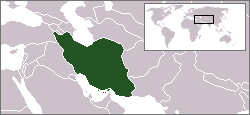Imperial State of Iran
From Themarshallwiki
| Dowlat-e Shahanshahi-ye Iran Imperial State of Iran | |
| | |
 | 
|
| Flag | Coat of arms |
| | |
| Motto Mara dad farmud va khod davar ast "Justice he bids me do, as he will judge me" | |
| Anthem Sorood-e Shahanshahi Iran (Imperial Salute of Iran) | |
| | |

| |
| | |
| Capital Largest city | Tehran Tehran |
| | |
| Official languages | Persian (Farsi) |
| | |
| Government - Shah - Prime Minister | Constitutional monarchy Reza Shah II Jamshid Savadkouhi |
| | |
| Establishment - Median Kingdom - Pahlavi dynasty established - Islamic Republic established - Pahlavi dynasty returned | 625BC 1925 1979 2009 |
| | |
| Area - Total - Water (%) | 1,648,195 km2 636,372 sq mi 0.7 |
| | |
| Population - July 2008 est. - Density | 70,472,846 42/km2 109/sq mi |
| | |
| GDP - Total - Per capita | 2008 estimate $382.328 billion $5,246 |
| | |
| Gini | 44.5 (medium) |
| | |
| HDI | 0.777 (medium) |
| | |
| Currency | Iranian rial (IRR)
|
| | |
| Time zone - Summer (DST) | IRST (UTC+3:30) (IRDT) (UTC+4:30) |
| | |
| Internet TLD | .ir |
| | |
| Calling code | +98 |
Iran is a constitutional monarchy in central Eurasia. Its official name is the Imperial State of Iran. The name Iran is a cognate of Aryan, and means "Land of the Aryans". Iran is a founding member of the UN, NAM, OIC and OPEC. The political system of Iran, based on the 2009 Constitution, comprises several governing bodies. The highest state authority is the Shah. Iran has no official religion and Persian is the official language.
The Imperial State of Iran was formerly the Islamic Republic of Iran.
Contents |
Provinces and Cities
Iran is divided into thirty provinces (ostan), each governed by an appointed governor (ostandar). The provinces are divided into counties (shahrestan), and subdivided into districts (bakhsh) and sub-districts (dehestan).
Iran's major cities are Tehran, Isfahan, Ahvaz, and Qom.
Politics and Government
Local City Councils are elected by public vote to four-year terms in all cities and villages of Iran.
Foreign Relations
Iran has difficult relations with most of the world. Iran's foreign relations are based on two strategic principles: eliminating outside influences in the region and pursuing extensive diplomatic contacts with developing and non-aligned countries. Iran maintains diplomatic relations with almost every member of the United Nations, except for Israel, which Iran does not recognize, and the United States since the Iranian Revolution.
Since the return to constitutional monarchy, Iran's relations with the world have improved greatly.
Armed Forces
Iran has two types of armed forces, the regular forces (Imperial Iranian Army, Imperial Iranian Navy, Imperial Iranian Air Force), and the Iranian Imperial Guard. Iran's armed forces have about 850,000 regulars, and 20,000 IIG.
The embargo on foreign arms has forced Iran to develop a military industry producing tanks, small arms, artillery, ballistic missiles.
Economy
Iran's economy is a combination of state central planning, state-ownership of oil and other large enterprises, village agriculture, and small scale, privately owned trading ventures.
